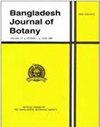西番莲黄酮3-羟化酶(f3h)基因的克隆及功能分析
IF 0.3
4区 生物学
Q4 PLANT SCIENCES
引用次数: 0
摘要
黄酮3-羟化酶(F3H)在黄酮类化合物的生物合成中起着至关重要的作用。本研究从西番莲(Passiflora edulis Sims)中克隆了一个编码序列为1161 bp的F3H基因(P_edulia040010337.g),该基因编码386个氨基酸残基。PeF3H蛋白包含一个非血红素双加氧酶(DIOX-N超家族)结构域和一个典型的F3H蛋白功能结构域(ogg - fei - oxy双加氧酶)。系统发育分析表明,PeF3H蛋白与黄桫椤(Turnera subulata)、白杨(Populus alba)和毛白杨(Populus tomentosa)的F3H蛋白具有较高的相似性,氨基酸序列同源性达88%。PeF3H蛋白缺乏跨膜结构,表明它可能在线粒体中表达。此外,基于同源蛋白对PeF3H的三维结构、蛋白与蛋白相互作用以及KEGG通路进行了预测。qRT-PCR分析显示,PeF3H在叶片中高表达,其次是茎和根。这些研究为揭示类黄酮生物合成的分子机制提供了新的思路,并为改善百香果的营养和药用特性提供了潜在的基因工程靶点。[j] .植物学报,52(2):613-623,2023 (6).本文章由计算机程序翻译,如有差异,请以英文原文为准。
Molecular cloning and functional analysis of flavanone 3-hydroxylase (f3h)gene in Passiflora edulis Sims
Flavanone 3-hydroxylase (F3H) plays a crucial role in the biosynthesis of flavonoids. In the present study, one F3H gene (P_edulia040010337.g) from Passiflora edulis Sims, which has a coding sequence (CDS) of 1161 bp, encoding a protein consisting of 386 amino acid residues was cloned. The PeF3H protein contains a non-heme dioxygenase (DIOX-N superfamily) domain and a typical F3H protein functional domain (2OG-FeII-Oxy dioxygenase). Phylogenetic analysis revealed that the PeF3H protein shared high similarity with F3H proteins in Turnera subulata, Populus alba, and Populus tomentosa, with 88% identities of amino acid sequences. The PeF3H protein lacks a transmembrane structure, indicating it is likely to be expressed in the mitochondria. Additionally, 3D structure, protein and protein interaction, and KEGG pathway of PeF3H were anticipated based on homologous proteins. qRT-PCR analysis showed that PeF3H was highly expressed in leaves, followed by stems and roots. These studies have provided insights into the molecular mechanisms underlying flavonoid biosynthesis and predicted potential targets for genetic engineering to improve the nutritional and medicinal properties of passion fruit. Bangladesh J. Bot. 52(2): 613-623, 2023 (June) Special
求助全文
通过发布文献求助,成功后即可免费获取论文全文。
去求助
来源期刊

Bangladesh Journal of Botany
生物-植物科学
CiteScore
0.80
自引率
0.00%
发文量
77
审稿时长
9 months
期刊介绍:
Bangladesh in situated on the north of Bay of Bengal. Climatically it is a humid subtropical country. Most of the land is deltaic plain of two great rivers, the Ganges and the Bhrammaputra and it tributaries. The country has rich diversity of plants. Main crops cultivated are Rice, Jute, Wheat, Maize, Sugarcane, Mustard and different kinds of Lentils. There are a good number of Public and Private Universities and Plant Research Establishments.
Bangladesh Journal of Botany is the official organ of the Bangladesh Botanical Society established in 1972. Since 1972 Bangladesh Journal of Botany is being published regularly. Two issues of the Journal are published, one in June and another in December.
Scientific papers (Full paper and short communication) on any field of Plant Sciences from anywhere in the World are considered for publication in Bangladesh Journal of Botany.
 求助内容:
求助内容: 应助结果提醒方式:
应助结果提醒方式:


